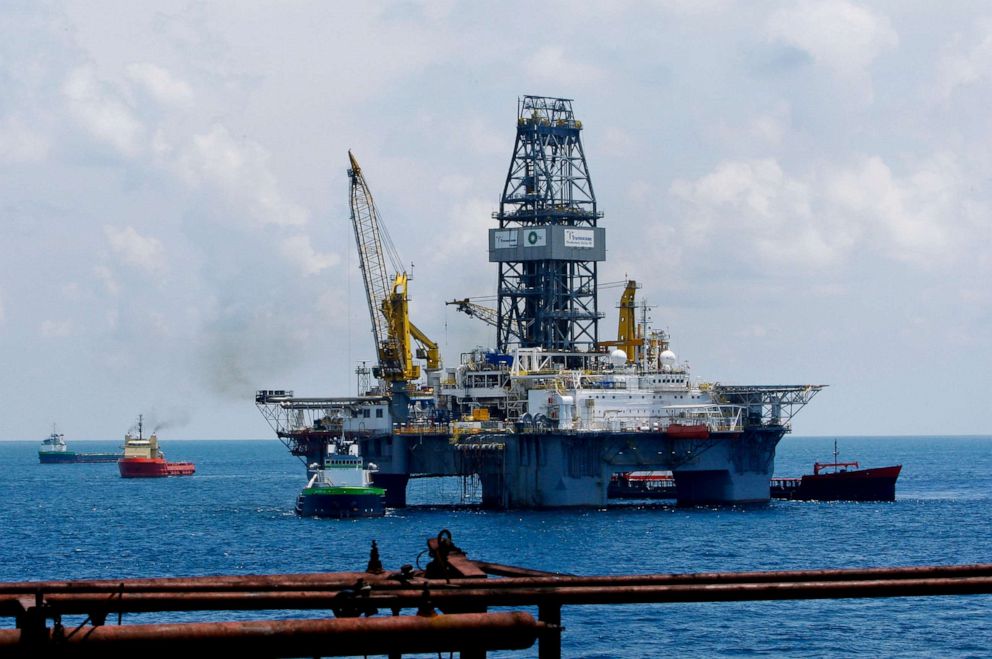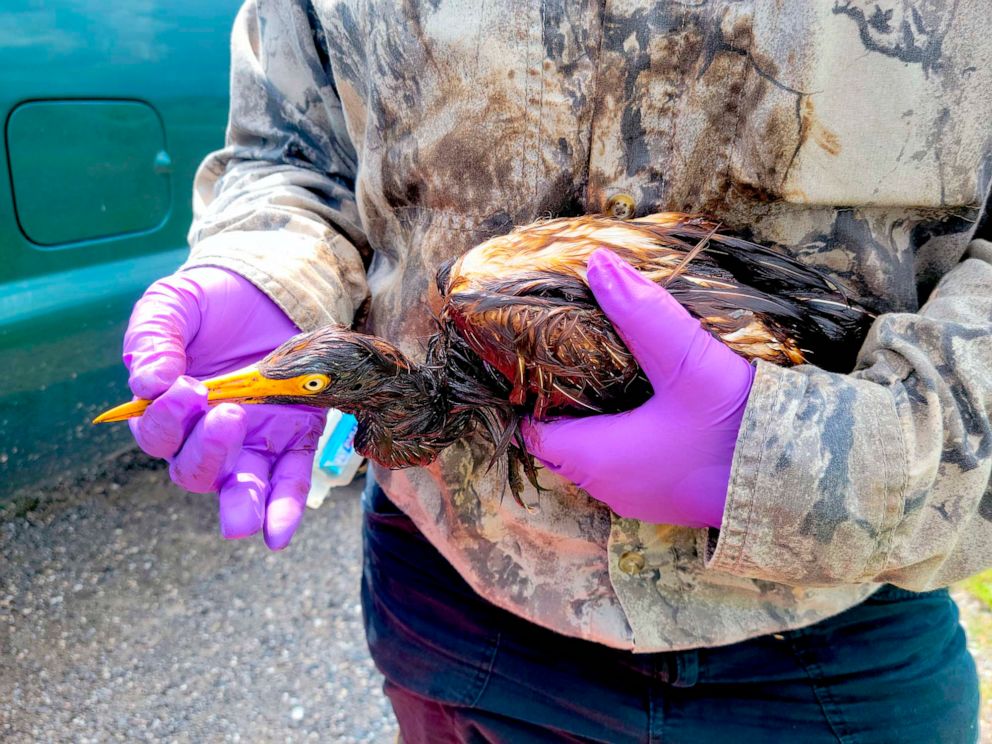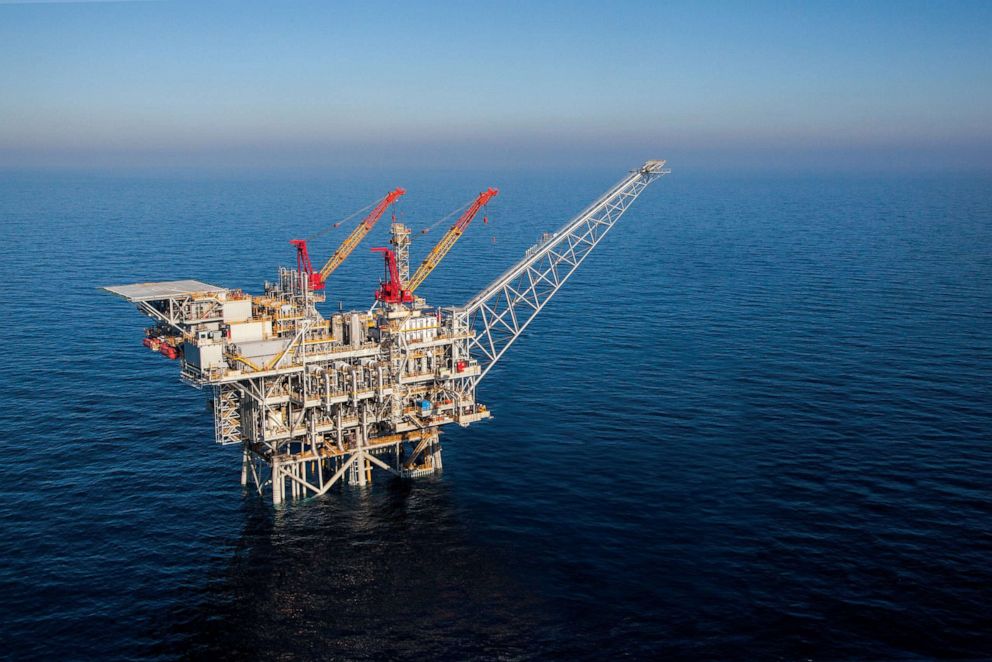Risk of oil spills may rise as climate change creates more monster storms
Hurricanes can lead to a destructive domino effect.
Hurricane Ida left a trail of destruction after slamming into the Gulf Coast, but offshore the Category 4 storm left something else in its wake: oil spills.
Oil spills aren't uncommon with strong storms, but as climate change pushes up sea levels and creates stronger storms with more moisture, offshore refineries are going to need greater and greater protections.
The Gulf of Mexico is "particularly vulnerable" because of the prevalence of storms, the low-lying geography, sea-level rise, receding shorelines and the presence of oil facilities, Christopher Vaccaro, a spokesman for the National Oceanic and Atmospheric Administration, told ABC News. Since offshore drilling began in the region in 1942, about 6,000 oil and gas structures have been installed in the Gulf of Mexico.
On Sept. 4, the day before Ida made landfall in Louisiana, the Coast Guard announced that cleanup crews already were responding to a large oil spill at an offshore drilling about 2 miles south of Port Fourchon, Louisiana.
The oil, which came from an underwater pipeline, appeared in satellite images to drift east for dozens of miles. More than 100 birds were found to be soaked in crude oil, according to the Louisiana Department of Wildlife and Fisheries, and the Coast Guard began investigating nearly 350 reports of oil spills as a result of the storm.
"We've seen the damage that hurricanes do in regions that have offshore drilling and oil production and refining," Jacqueline Savitz, chief policy officer for ocean conservation nonprofit Oceana, told ABC News. "And we can expect that to continue."

Oil spills are just another disastrous consequence from natural disasters made worse by warming temperatures.
More devastating storms
One of the many destructive results of Hurricane Katrina in 2005 was the 8 million gallons of oil spilled as a result of the Category 5 storm. And more similar storms are expected.
Warming temperatures will increase the number of strong storms as well as the amount of moisture in them, wreaking havoc on infrastructure both onshore and offshore. Warmer sea temperatures allow the storm systems to intensify, while the increased moisture means to more rainfall and storm surge.
The record-setting 2020 hurricane season already has been rivaled in 2021 -- with more than two months left in the season.
"It seems pretty clear now that we can expect an increase in the frequency and intensity of storms," Savitz said. "We're seeing that happening ... and it's only going to continue to get worse."
There are several ways oil can leak into the ocean as a result of turbulent weather, Savitz said. An underwater pipeline can be disturbed, coastal storage facilities may be battered or rigs and refineries could take a direct hit.
"You've just got a lot of infrastructure there, and a lot of oil in a lot of different sort of forms," she said. "That can lead to spills from platforms, from rigs, from production facilities -- you name it."
'Not going to get that back'
As cleanup crews race to contain spillage, the oil -- most of which can't be recovered -- makes its way to nearby coasts, blacking out beaches, suffocating wildlife and affecting local businesses and tourism, Savitz said.
Marine life populations are decimated as the oil moves from the sea into marshes and other wetlands. The portion of the oil that's soluble dissolves and is especially dangerous to wildlife, Savitz said.
"You're not going to get that back," she added.
In 2010, the Deepwater Horizon disaster resulted in more than 205 million gallons of methane from a BP facility ending up in the Gulf of Mexico. Only about 25% of it was recovered, while some 82,000 birds, 6,165 sea turtles, 25,900 marine mammals and a "vast" number of fish -- from bluefin tuna to seahorses, plus oysters, crabs and coral -- were harmed or killed, according to an assessment by the Center for Biological Diversity, an environmental conservation nonprofit.
Years after the Deepwater Horizon spill, crews still were finding remnants of the leaked oil in the environment, Savitz said.
Much of the oil eventually makes its way into the air as sea spray or evaporating water, leaving behind an oily residue on shores, said Rick Luettich, director of the University of North Carolina at Chapel Hill Institute of Marine Sciences.

'Prepared for that sea-level rise'
As global temperatures rise, melting ice in the Arctic is the biggest contributor to sea-level rise, the single biggest threat to oil production facilities.
"The Gulf Coast and the entire Atlantic coast needs to be prepared for that sea-level rise," Luettich told ABC News. "As storms get stronger, coupled with sea-level rise, there's no question that coastal areas are going to see more water."
The Greenland ice sheet, the biggest contributor to sea level rise, has added about 10 millimeters to ocean levels over the last 15 years alone, Marco Tedesco, a polar scientist specializing in Greenland for the Lamont-Doherty Earth Observatory at Columbia University, told ABC News.
That, combined with increased rain from storm systems, is enough to do significant damage to the existing structures and businesses need to take that threat seriously, Luettich said.
"Whether the water is coming from the ocean up onto the land or from the sky, when it comes in contact with any type of of industrial or other infrastructure, that infrastructure needs a higher level of preparedness, a higher level of readiness to deal with the future," he said.

'Not rocket science'
The No. 1 solution -- both for preventing oil spills and mitigating climate change -- is for the world to embrace clean energy and stop relying on fossil fuels, Savitz said.
"It's not rocket science," she said. "It's part of making a shift to clean energy so that we can curb the worst impacts of climate change and start rebuilding systems so that we can survive this."
But weather and climate aren't the only factors in predicting potential spills, according to NOAA's Vaccaro. The location and condition of infrastructure is immensely important, he said.
Strengthening the rigs to ensure they can withstand the brunt of the storm is an important first step, as is checking that underwater pipelines can withstand stronger waves, Luettich added.
"Any of the structures that you have," he said, "need to be ready to be able to exist through those stronger conditions."




